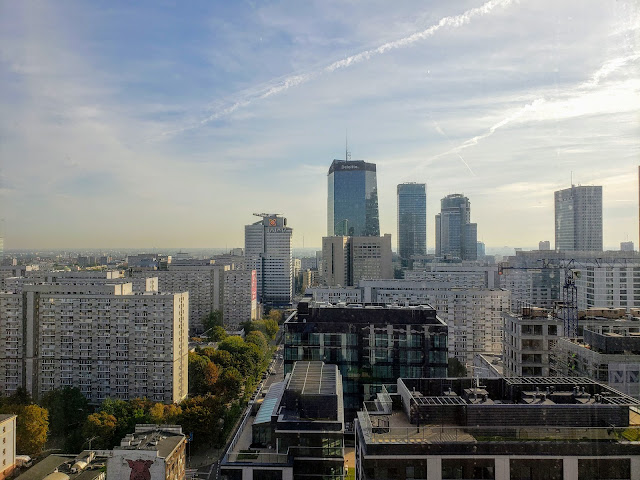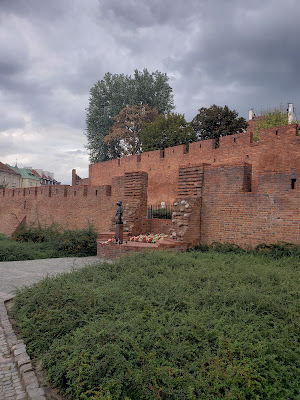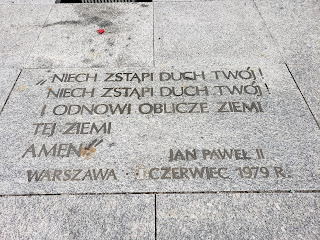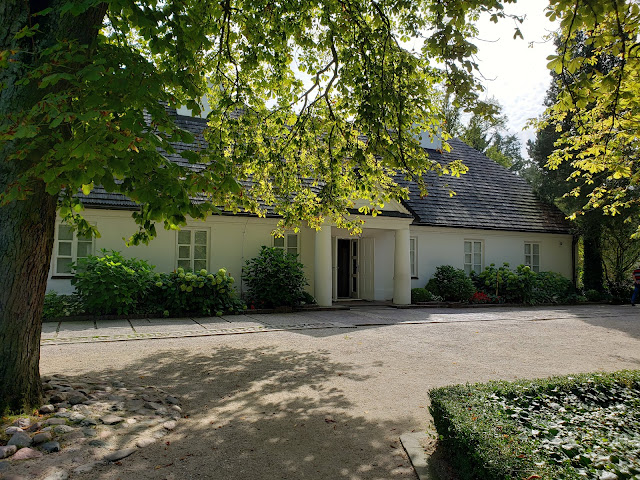The next day was a travel day. We flew from Vilnius to Warsaw on the Polish National airline. I'm not sure of the age of our plane, but I do know that the seat cushions had reached their best before date. They were like those old, saggy couches where everyone slides toward the centre. Luckily, there were only two seats on each side of the aisle, so Barry and I were very cosy as we slid toward each other.
Our captain announced that the weather was fine in Warsaw, although we should be prepared for a bit of turbulence, but not to worry, as we all had seatbelts provided free of charge. However, there was no turbulence and so we arrived quite early. We had a few extra turns around the airport as we waited for a landing strip. Once on the ground, we had another wait. Our captain informed us that they had called for the ground crew to bring the stairs and baggage carts, but there is quite a staff shortage. He advised us if we were considering a career in aviation that working at the Warsaw airport could be a good place to start.
Finally, we deplaned and wandered around, looking for our luggage. After some time, we located the proper baggage carousel and tried not to panic that we were the only passengers from our flight waiting there. Our bags eventually arrived on our private carousel and we set off to find our driver. Even with all the delays, we had still managed to get to the meeting point before she did. However, she found us and took us to our hotel.
 |
our view- note the sign for the Red Hog restaurant on the lower left
|
After we checked in, we set out for a nearby restaurant that had been recommended. It is located in a former working class district, the kind of area where the Polish socialist/communist movement took root. The Inn Under the Red Hog was named after the Reds who frequented the inn, such as Lenin and later party dignitaries loved holding secret meetings there. The food is based on the favourites of those leaders. The beer was cold and delicious and the food tasted wonderful.
 |
Barry with beer and Communist items in the background
|
We spent the rest of the day hanging out in our giant hotel room- again, we had an adjoining sitting room and it was a relief to have room to spread out and relax.
The following day was devoted to sights outside of Warsaw.
We visited Chopin's birthplace, where his French father was employed by a Polish Count as a (French) tutor for his children. Chopin's mother was an impoverished Polish noblewoman who was a companion to the Count's wife. There the couple met, fell in love, married, and it was there that Chopin was born. Their home there is now a museum; concerts are regularly held, with the piano played in the house and broadcast to the audience seated in the garden.

 |
temporary exhibition of Chopin busts
|
Arkady is an historical site, an enormous English style garden of ruins built in the late 1700s at the behest of Princess Helena as a place of contemplation of poetry and also to entertain close acquaintances for enlightened discussions of the mysteries of life. From the brochure: The themes of the garden, as described by Princess Helena in a guidebook, were Love, Beauty, Happiness and Death.... It has a serpentine lake, an Amphitheatre, a Gothic House, an Island of Feelings, an Island of Poplars, a Roman Aqueduct and a Temple of Diana.

We found it interesting to think about the process of building architectural ruins- would you have to first design the structure as a whole and then decide how it would crumble over time?
Our final stop was another baroque summer palace built at the end of the 12th century with a French style garden. I think we would have been more impressed if this wasn't the umpteenth baroque palace we had seen and if the gardens had been in the immaculate conditions of the others. It did, however, have beautiful tapestries and sculptures as well as impressive collections of books in the libraries.

 |
| one of the few pagan statues in existence |
It was good to get out of the city and to see some of the Polish countryside- when we weren't seeing the sound/sight barriers erected alongside much of the major highways. These barriers are everywhere along major roadways in and out of the cities.
 |
| the countryside |
 |
the barrier
|
The next day we took the train to Krakow, a very comfortable journey of just over two hours. It was a great way to travel, especially as the rules of no loud talking and no blaring of music and no calling on cell phones are adhered to by all those on board.
Our driver whisked us off to our hotel where we sadly did not have a huge room. About an hour later, his wife (and boss- actually true) picked us up for a tour of the old town. There are many, many churches and remnants of castles there! It's also a pretty vibrant tourist area, full of shops and restaurants and a huge market in the square.


That night we walked to the Jewish quarter where there are also dozens of sidewalk cafes, but less frantic than the old town. We had a great meal along with a refreshing beverage while the haunting music of a klezmer band playing at a nearby restaurant drifted around the square.
The next day was our last day of touring. It was a long and difficult day, as we went to Auschwitz. The former concentraton camp is located about an hour and a half from Krakow and is one of the most visited places in Poland. We toured Auschwitz I, originally an army barracks and primarily used to house inmates/forced labourers, and Auschwitz II, a concentration and death camp.

 |
| execution wall |

 |
crematorium chimney
|
We cried several times- there are buildings that contain rooms full of items taken from the people imprisoned and murdered there: a room of thousands of shoes; a room of brushes, mostly hairbrushes but also shaving brushes, toothbrushes, etc.; rooms of hair- the Nazis forced inmates to cut off the hair of new arrivals which was sent to Germany where it was used to create fabric. We found the saddest display to be the children's shoes. The scale of the place is overwhelming- the initial camp is small, but the second camp is vast. 1.1 million people were killed there. As the war was ending, the Nazis destroyed as much as they could, including the meticulous records they kept. However, shortly after the Nazis left Auschwitz, Poles, including many former prisoners, returned to reconstruct the buildings so that the camp could operate as a museum. Their intent was to ensure that what happened there was not forgotten and so could not happen again.
 |
one of the women's barracks at Auschwitz II
|
We were glad to have a long drive back so that we could try to process what we had seen.
That evening, we had one of the best meals we have ever had. I did not know that perogies could be so delicate and so delicious. Our entrees were pretty close to spectacular and we did enjoy a refreshing adult beverage or two as well. (This might explain why we stopped to buy shoes at a nearby shop, although we had no intentions of doing so.)
The next day we took the train back to Warsaw then checked in to the airport hotel. It was surpringly quiet and lovely. We enjoyed our last sauna/steam bath/swim before eating an early dinner and packing up for our early flight. The hotel advertises that it is 68 steps from Departures and we were glad to find this to be true when we walked over at 5:30 a.m.
We had a wonderful time on this tour- so many castles and palaces and gardens and churches and potatoes and bread and dumplings and glasses of beer! We saw forests and bogs and dunes and seashores and farmlands and lagoons and bays and gulfs; we traveled in planes and cars and bikes and ferries and trains. Best of all, we met some wonderful people, passionate about their history, culture, and their countrymen. We learned so much from them- really, this is the reason we travel.




































































Comments
Post a Comment